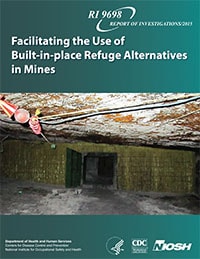Mining Publication: Facilitating the Use of Built-in-place Refuge Alternatives in Mines
Original creation date: April 2015
Authors: JD Trackemas, ED Thimons, ER Bauer, M Sapko, RK Zipf Jr., JE Schall, EN Rubinstein, GL Finfinger, LD Patts, N LaBranche
NIOSHTIC2 Number: 20045972
Pittsburgh, PA: U.S. Department of Health and Human Services, Public Health Service, Centers for Disease Control and Prevention, National Institute for Occupational Safety and Health, DHHS (NIOSH) Publication No. 2015-114 (RI 9698), 2015 Apr; :1-80
Three major coal mining disasters occurred in 2006, involving either fires or explosions, killing 19 miners. In all of these tragedies, miners survived the initial disaster but were unable either to escape or successfully isolate themselves from the poisonous gases present in the mine environment resulting from the disaster. In response, Congress passed the Mine Improvement and New Emergency Response Act (MINER Act) of 2006 (Public Law 109-236). Among its mandates, the MINER Act called for the National Institute for Occupational Safety and Health (NIOSH) Office of Mine Safety and Health Research (OMSHR) to “provide for the conduct of research, including field tests, concerning the utility, practicality, survivability, and cost of various refuge alternatives in an underground coal mine environment, including commercially-available portable refuge chambers.” The primary function of a refuge alternative (RA) is to provide safe refuge for miners unable to escape their work area immediately after a disaster due to toxic gases or a blocked escapeway. To be effective, the RA must survive the initiation of the disaster, whether it is an explosion or fire. Furthermore, it would additionally be beneficial if it would protect the miners inside the RA from the blast impacts of a secondary explosion.
In response to the MINER Act mandate, NIOSH OMSHR conducted research on refuge alternatives and provided its findings in the form of a 2007 report to Congress. In sum, this report found that refuge alternatives were practical for use in most underground coal mines to facilitate escape and to serve as a refuge of last resort, provided that mine operators develop comprehensive escape and rescue plans incorporating refuge alternatives and training on their use. These findings applied to both portable RAs and built-in-place (BIP) RAs, with the BIP RAs emerging as being able to provide a superior environment. In an emergency when immediate escape is not possible due to toxic gases or a blocked escapeway, BIP RAs offer the potential to provide miners with an improved psychological and physiological environment, both because the available air makes the space more comfortable and due to the larger amount of space provided per occupant. Boreholes or protected compressed air line air supply systems also provide a much higher probability of there being communications to the RA.
Despite these advantages, current BIP RA designs cannot be moved frequently from a practical standpoint—with movement of the RA location required to keep up with dynamic mining production—and as such it would generally be impractical to keep them within 1,000 feet of the nearest working face, as prescribed in 30 CFR 75.1506(c). Notwithstanding, OMSHR’s 2007 report to Congress on refuge alternatives concluded that, as compared to portable RAs, the strengths of built-in-place refuge alternatives “are so significant that consideration should be given to allowing extended distances, if in-place shelters are used to provide refuge for face workers."
Currently, there are approximately 30 BIP RAs in U.S. underground coal mines; however, all of these are located outby the face area and none are designed to be advanced with the working face. The usage of BIP RAs that can be advanced with the working face will only be practical if three issues can be addressed: (1) locating BIP RAs further from the face; (2) providing a consistent process for the design and approval of RA stoppings; (3) delivering a reliable supply of clean, breathable air to a BIP RA. In this Report of Investigations, these three issues are explored in detail.

NIOSHTIC2 Number: 20045972
Pittsburgh, PA: U.S. Department of Health and Human Services, Public Health Service, Centers for Disease Control and Prevention, National Institute for Occupational Safety and Health, DHHS (NIOSH) Publication No. 2015-114 (RI 9698), 2015 Apr; :1-80